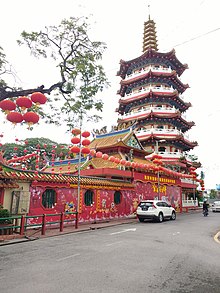| Tua Pek Kong Temple | |
|---|---|
 The Tua Pek Kong Temple | |
| Religion | |
| Affiliation | Taoism |
| District | Sibu District |
| Location | |
| Location | Sibu |
| State | Sarawak |
| Country | Malaysia |
| Geographic coordinates | 2°17′14″N 111°49′34″E / 2.28722°N 111.82611°E |
| Architecture | |
| Type | Chinese temple, pagoda |
| Date established | 1850s [1] |
Tua Peh Kong Temple ( Chinese: 永安厅大伯公庙; Pe̍h-ōe-jī: Éng-an-thiaⁿ Tōa-peh-kong-biō) (also called Sibu Eng Ann Teng Tua Peh Kong) [2] in Sibu, Sarawak, Malaysia is the oldest Chinese temple in the town with a 7-storey pagoda with the temple history dates back to 1850s. [1]
History
The temple history dates back to early 1850s, [1] and later being mentioned in the Kingdom of Sarawak Government's Report of "Sarawak Gazette" in 1871. [2] [3] [4] In 1897, the temple was rebuilt into a typical Chinese Taoist temple architecture designed with tiled roof, stone block floor and all the decorative purlin and fixtures which were imported from China; the statue of Tua Pek Kong deity was specially sculptured and imported from Xiamen. [3] After the building was completed, the list of donors and details of expenditure were recorded in two pieces of stone tablet which are still well preserved in the temple. On 8 March 1928, Sibu town was destroyed by a big fire with the temple survived and remain unscathed. The temple however destroyed through the World War II despite its deity remained unharmed. After the end of the war, the wooden structure temple was rebuilt. [4]
In 1957, the temple was reconstructed into a concrete structure and was declared open by the then Governor of Sarawak, Sir Anthony Abell. [2] It was a grand occasion for the Sibu Town as the British Royal dignitaries including the Resident attended the ceremony. Another renovation on both wings of the temple was being carried out in 1979 and the roof of temple was changed from "belian" ( Eusideroxylon zwageri) wood into concrete with glazed roofing tiles; the ridge or roof and column were decorated with traditional dragon and phoenix statues. [2] In 1982, the temple management committee planning to re-build the rear part and construct a 7-storey pagoda for the worship of the Goddess of Mercy where the plan is being realised in 1987 through the aid from Sarawak state government and the temple worshippers. [2] [4] [5] The new pagoda followed closely the traditional Chinese pagoda architecture and subsequently became one of the landmark for Sibu. The renovated building was declared open in 1989. [5]
References
- ^
a
b
c
"Foreign scholars learn a lot during visit to Tua Pek Kong Temple Sibu". The Borneo Post. 26 February 2018. Retrieved 20 February 2019 – via
PressReader.
It is recorded that Tua Pek Kong Temple Sibu was built in the 1850s – in 1871, its existence was mentioned on the Sarawak Gazette. It is said that this house of worship was built by the river as a means to offer thanksgiving to the deities, as well as to seek comfort and blessings.
- ^ a b c d e Conny Banji (4 December 2013). "Tua Pek Kong Temple very much a tourism icon". The Borneo Post. Archived from the original on 20 February 2019. Retrieved 20 February 2019.
- ^ a b "Tua Pek Kong Temple & Goddess of Mercy Pagoda, Sibu". Sarawak Tourism. Archived from the original on 20 February 2019. Retrieved 20 February 2019.
- ^ a b c "Tua Pek Kong Temple / Goddess of Mercy Pagoda". VisitSibu.com. Retrieved 20 February 2019.
- ^ a b "Amazing Sarawak – Part 7". New Sarawak Tribune. 26 April 2017. Archived from the original on 21 February 2019. Retrieved 21 February 2019.
External links
-
 Media related to
Tua Pek Kong Temple, Sibu at Wikimedia Commons
Media related to
Tua Pek Kong Temple, Sibu at Wikimedia Commons
